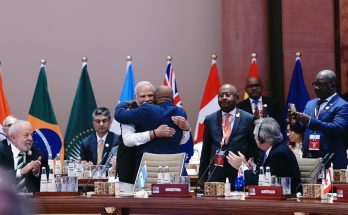May 25 is Africa Day and it is an opportune moment to reflect on the expanding India-Africa partnership. This is also the time when there is a general buzz about the resurgence of Africa. A list of the fastest growing economies of the world in 2011 had six from Sub-Saharan Africa. The economic boom in Africa has also led to a perceptible reduction in poverty levels. With multi-party democracy taking root in most African countries and regular elections becoming a norm in many of them, good governance and transparency have become essential factors in the political arena.
Mapping India-Africa partnership
India, an emerging economy and the world’s most populous democracy, is ideally placed to partner with the resurgent continent in a multitude of sectors. The India-Africa partnership is nothing new; it dates back several centuries. Even though the contacts were adversely affected during the colonial period, the momentum in the engagement was picked up after the independence of India and the African nations. India, in fact, was in the forefront in the efforts for decolonisation of Africa and the end of apartheid in South Africa. India’s engagement with Africa has been founded on four important factors: firstly, a sense of solidarity with the African countries; secondly, there is no fundamental conflict of interest with any of the African countries or the continent as a whole; thirdly, there is a feeling of shared historical experiences, and lastly the conviction that because of similar socio-economic conditions, common solutions can be found if they work together.
Between 1960 and 1980, India and the African countries collaborated effectively in multilateral fora like the Non-Aligned Movement (NAM), G-77 and the United Nations. It was a colossal task in those days to thwart attempts by the West to marginalise India and Africa or the “third world,” as they were referred to.
Trade Upswing
Things changed for the better with the end of the Cold War. The resurgence of Africa, both in political and economic terms, and India’s own economic growth making it one of the most important emergent powers have set the stage for taking the partnership to higher levels. Since political relations between the two sides have always been excellent, the new transformation can be visibly seen in the economic sphere, particularly in trade and investments. The growth in bilateral trade is truly spectacular. It expanded from a mere $20 billion in 2005 to $53 billion in 2010 and is expected to reach $ 90 billion by 2015. India’s investments have also kept pace with the increase in trade. Today India’s investment in Africa is around $50 billion, of which $ 35 billion are from the public sector (mainly in extractive industries) and the $15 billion are from the private sector. There are 245 Indian companies which have investment linkages with Africa. Investment in the reverse direction i.e, from African countries into India is also picking up, albeit at a modest rate; today it is $ 110 million. Some of the big Indian corporates doing business in Africa include, among others, Bharti Airtel, TATA, Kirloskar, Mahindra, Bajaj, Ranbaxy, Cipla, Essar Group and NIIT.
Beyond Summits
While the future of the India-Africa economic partnership will be mainly driven by the private sector, the Indian government is taking many proactive measures. The establishment of the India-Africa Forum Summit in 2008 was a step in this direction to give added momentum to the engagement. So far, two such summits have been held – the first in New Delhi in 2008 and the second in Addis Ababa in 2011. The third is expected to be held in New Delhi in 2014. The decisions taken in these summits have made a qualitative difference in the nature of engagement. In the first summit, India unilaterally offered preferential market access to exports from 34 Least Developed Countries (LDCs) in Africa. The Lines of Credit (LOCs) pledged in the two summits amount to over $7.5 billion. In addition, $300 million were earmarked for the Ethiopia-Djibouti railway line.
One of the biggest bottlenecks in India’s Development Partnership with Africa has been the rather slow implementation of projects under LOCs (soft loans). This had led to legitimate criticism of the procedures and processes. The recent establishment of a dedicated Development Partnership Administration (DPA) in the Indian Ministry of External Affairs (MEA) will go a long way in addressing the issue. The DPA’s main focus will be to monitor the various projects and expedite them from the concept stage to the final handover to the host countries where these new facilities of empowerment are to be located.
Human Capital
Human resource development and capacity building have been the hallmark of India’s Development Partnership which is based on three fundamental principles as reiterated by India’s foreign secretary in a recent conference: India does not attach conditionalities, does not prescribe policies and also does not question sovereignty. Hence, India avoids the donor-recipient model of Western development assistance. The cooperation is driven by the demands of the partners.
India’s flagship initiative on South-South Cooperation is the Indian Technical and Economic Cooperation (ITEC) Programme. This was initiated in 1964 and the emphasis was on capacity building even though it had other elements like institution building and project assistance. Under this scheme, thousands of young African men and women have been trained in agriculture, accountancy, hydrology, information technology, management and small and medium industries. In keeping with this tradition, the India-Africa Forum Summits have also laid stress on this aspect of cooperation. In the first Summit the number of ITEC scholarships were increased from the existing 1000 to 1500 annually. In the second summit, there was a commitment to train 20,000 African students in the next three years. A logical step in this field was to establish training centres in the African countries themselves and an amount of $700 million was earmarked for this initiative.
Demographic Dividend
Much has been written about the demographic dividend of Africa. A McKinsey report in 2010 predicted that by 2040, there will be 1.1 billion Africans of working age. With the rest of the world having older populations by then, Africa will be poised to become the main manufacturing hub of the globe. If the right kind of investments can be made in human capital today, Africa will be well placed to take up that challenge. It is in this context that the capacity building initiatives of India acquire added significance.
South-South Success Story
Many African leaders and opinion makers are of the view that India can make two great contributions, which involve leading the new industrialisation drive in Africa and also shepherding the efforts to build the human resources necessary for that. This is an endeavour worth striving for and it could create a new paradigm for South-South Cooperation.
(H.H.S. Viswanathan is a Distinguished Fellow at the Observer Research Foundation (ORF), New Delhi. He has been ambassador/high commissioner to many African countries, including Nigeria and Cote d’Ivoire. The views expressed in this column are his personal reflections on the play of the evolving India-Africa relationship).
Author Profile
Latest entries
 DiplomacyAugust 29, 2017Bolstering Brics: Mapping New Pathways
DiplomacyAugust 29, 2017Bolstering Brics: Mapping New Pathways Africa InsightsDecember 18, 2015FOCAC 2015: Consolidating China-Africa relations
Africa InsightsDecember 18, 2015FOCAC 2015: Consolidating China-Africa relations Africa InsightsApril 16, 2015A landmark election, and a new President
Africa InsightsApril 16, 2015A landmark election, and a new President China ConnectNovember 6, 2014China’s efforts to improve Rule of Law
China ConnectNovember 6, 2014China’s efforts to improve Rule of Law








